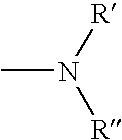Biologically active methylene blue derivatives
a methylene blue, biologically active technology, applied in the direction of antimycotics, intraocular lenses, energy modified materials, etc., can solve the problems of low photochemical antimicrobial activity, unsuitable or low efficacy of photodynamic therapy sensitisers, and restricted use of these photosensitisers, so as to maintain the sterility of the relevant surface, prolong the stability of the chromophore, and reduce the effect of toxicity
- Summary
- Abstract
- Description
- Claims
- Application Information
AI Technical Summary
Benefits of technology
Problems solved by technology
Method used
Image
Examples
example
[0252] Example
[0253] To a clear solution of cellulose triacetate (0.5 g) in dichloromethane (10 cm.sup.3) was added sensitiser (Formula 1 in which A=B=NR.sup.1R.sup.2 and R.sup.1=R.sup.2=n-Bu) (0.01 g) and the mixture was stirred until the sensitiser had dissolved completely. The solution was then cast on a glass plate and allowed to dry slowly, giving a clear blue film. The film showed typical singlet oxygen generating properties on exposure to light. Thus an aerated red solution of tetraphenylcyclopentadienone (a characteristic singlet oxygen detector) in toluene containing the film was rapidly bleached on exposure to light from a 40 w tungsten filament lamp. An identical solution showed no bleaching when irradiated for the same period of time in the absence of the film.
[0254] (b) Adsorption on Polymers
[0255] Phenothiazinium compounds Ia and Ib were made according to the following reaction scheme and were isolated as dark blue solids. They were characterised by mass spectrometry. ...
PUM
| Property | Measurement | Unit |
|---|---|---|
| wavelengths | aaaaa | aaaaa |
| pH | aaaaa | aaaaa |
| pH | aaaaa | aaaaa |
Abstract
Description
Claims
Application Information
 Login to View More
Login to View More - R&D
- Intellectual Property
- Life Sciences
- Materials
- Tech Scout
- Unparalleled Data Quality
- Higher Quality Content
- 60% Fewer Hallucinations
Browse by: Latest US Patents, China's latest patents, Technical Efficacy Thesaurus, Application Domain, Technology Topic, Popular Technical Reports.
© 2025 PatSnap. All rights reserved.Legal|Privacy policy|Modern Slavery Act Transparency Statement|Sitemap|About US| Contact US: help@patsnap.com



